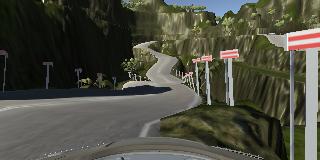In this project, you will use what you've learned about deep neural networks and convolutional neural networks to clone driving behavior. You will train, validate and test a model using Keras. The model will output a steering angle to an autonomous vehicle.
We have provided a simulator where you can steer a car around a track for data collection. You'll use image data and steering angles to train a neural network and then use this model to drive the car autonomously around the track.
The project's writeup can be found here.
According to the provided guidelines, a great writeup include the rubric points as well as a detailed description of how to addressed each of them and the code involved (with line-number references and code snippets where necessary), images to demonstrate how the code works with examples and links to other supporting documents or external references.
The goals/steps of this project are:
- Use the simulator to collect data of good driving behavior
- Design, train and validate a model that predicts a steering angle from image data
- Use the model to drive the vehicle autonomously around the first track in the simulator. The vehicle should remain on the road for an entire loop around the track.
- Summarize the results with a written report
This lab requires:
The lab enviroment can be created with CarND Term1 Starter Kit. Click here for the details.
The simulator can be downloaded from the classroom. In the classroom, we have also provided sample data that you can optionally use to help train your model.
Usage of drive.py requires you have saved the trained model as an h5 file, i.e. model.h5. See the Keras documentation for how to create this file using the following command:
model.save(filepath)Once the model has been saved, it can be used with drive.py using this command:
python drive.py model.h5The above command will load the trained model and use the model to make predictions on individual images in real-time and send the predicted angle back to the server via a websocket connection.
Note: There is known local system's setting issue with replacing "," with "." when using drive.py. When this happens it can make predicted steering values clipped to max/min values. If this occurs, a known fix for this is to add "export LANG=en_US.utf8" to the bashrc file.
python drive.py model.h5 run1The fourth argument, run1, is the directory in which to save the images seen by the agent. If the directory already exists, it'll be overwritten.
ls run1
[2017-01-09 16:10:23 EST] 12KiB 2017_01_09_21_10_23_424.jpg
[2017-01-09 16:10:23 EST] 12KiB 2017_01_09_21_10_23_451.jpg
[2017-01-09 16:10:23 EST] 12KiB 2017_01_09_21_10_23_477.jpg
[2017-01-09 16:10:23 EST] 12KiB 2017_01_09_21_10_23_528.jpg
[2017-01-09 16:10:23 EST] 12KiB 2017_01_09_21_10_23_573.jpg
[2017-01-09 16:10:23 EST] 12KiB 2017_01_09_21_10_23_618.jpg
[2017-01-09 16:10:23 EST] 12KiB 2017_01_09_21_10_23_697.jpg
[2017-01-09 16:10:23 EST] 12KiB 2017_01_09_21_10_23_723.jpg
[2017-01-09 16:10:23 EST] 12KiB 2017_01_09_21_10_23_749.jpg
[2017-01-09 16:10:23 EST] 12KiB 2017_01_09_21_10_23_817.jpg
...The image file name is a timestamp of when the image was seen. This information is used by video.py to create a chronological video of the agent driving.
python video.py run1Creates a video based on images found in the run1 directory. The name of the video will be the name of the directory followed by '.mp4', so, in this case the video will be run1.mp4.
Optionally, one can specify the FPS (frames per second) of the video:
python video.py run1 --fps 48Will run the video at 48 FPS. The default FPS is 60.
- It's been noted the simulator might perform differently based on the hardware. So if your model drives succesfully on your machine it might not on another machine (your reviewer). Saving a video is a solid backup in case this happens.
- You could slightly alter the code in
drive.pyand/orvideo.pyto create a video of what your model sees after the image is processed (may be helpful for debugging).
- Please keep in mind that training images are loaded in BGR colorspace using cv2 while drive.py load images in RGB to predict the steering angles.
-
Adam: A Method For Stochastic Optimization:
-
An Analysis of the Regularization between L2 and Dropout in Single Hidden Layer Neural Network.
-
NVIDIA End-to-End Deep Learning for Self-Driving Cars
https://devblogs.nvidia.com/parallelforall/deep-learning-self-driving-cars/
-
ReLU vs ELU:
http://saikatbasak.in/sigmoid-vs-relu-vs-elu/
https://www.picalike.com/blog/2015/11/28/relu-was-yesterday-tomorrow-comes-elu/
-
Nvidia looks to reduce AI training material through 'imagination':

